Alberto Dorigoni’s research on apple orchard design in northern Italy is having an impact well outside of his area, including in the United States.
Even as his research goes on, a few growers in the Great Lakes region are adopting his fruiting wall concept, including the use of mechanical hedging with sicklebar mowers to create them. Dorigoni’s work is influencing Dr. Terence Robinson at Cornell University, and Robinson has a large following of growers and tree fruit educators in New York and Michigan who believe this work is on the cutting edge of future orchard design.
In November, growers traveling on the International Fruit Tree Association’s study tour to Italy saw Dorigoni’s work firsthand. There, on about 30 acres in a valley surrounded by Alpine mountains, he has rows and rows of trees for evaluating novel orchard design concepts.
“We are looking at ways to be more sustainable,” Dorigoni said. “We want to use less labor, simpler pruning and thinning methods, and fewer chemical inputs.” In Italy and across Europe, herbicides such as paraquat can no longer be used, nor can carbaryl (Sevin) for thinning.
Dorigoni’s research takes place at the Institute of Agriculture at San Michele All’Adige experimental farm in Trento province south of Bolzano. There, he studies such things as fruiting walls of varying heights, tree spacings, and alley widths; multi-leader trees; mechanical pruning and hedging; mechanical thinning; alternative ways of spraying, such as tunnel sprayers to reduce drift and make more effective use of spray materials; and use of nets—to ward off not only hail but insects—and to create shade or exclude pollinators to affect fruit set without hand or chemical thinning.
He has also partnered with Cornell University entomologist Art Agnello (and indirectly with researchers in Washington State and Michigan) who are studying the solid-set canopy spray delivery (SSCD) system. In the SSCD, trees are sprayed with lines and nozzles permanently installed in the tree canopy. That could take sprayers out of orchards.
Past platforms
While many growers are just now moving toward greater use of platforms, Dorigoni said he is moving past platforms. While he agrees that very tall fruiting walls are “an option,” he is also looking at very short trees, grown in much narrower rows—“more vineyard-looking orchards.”
With shorter trees, it becomes easier to use nets to do things besides ward off hail. They can be used to create shade to make apples easier to thin; they can be used to exclude insects such as codling moth; they can be used to exclude bees and other pollinators, so thinning can be achieved by allowing only the earliest blooms to be pollinated and then covering the trees with nets.
Every foot that trees are shortened allows alleys to be a foot narrower. He thinks an alley a meter and a half wide—five feet—would be adequate.
Multiple trunks
About 15 years ago, an Italian nursery, Mazzoni, developed bi-axis trees and called them Bibaum—two trees on one root. Not only should it be somewhat cheaper to plant one tree where two were planted before, the double leaders provided a new option for vigor control.
Dorigoni has taken that idea several steps further. “The number of leaders can be a variable to use according to the strength of the soil and the variety,” he said.
 He has developed trees with three leaders, by training two side limbs off a central leader. He has developed four leaders by splitting two bi-axis leaders.
He has developed trees with three leaders, by training two side limbs off a central leader. He has developed four leaders by splitting two bi-axis leaders.
In his experimental plantings, he has trees that look like the Upright Fruiting Offshoot cherry trees developed at Washington State University and being tested across the United States now.
The two trunks on a bi-axis apple tree are bent over to horizontal and the limbs that grow upward from those trunks bear the fruit. “Treat them as individual small spindles,” Dorigoni said. Renewal pruning is used to take out the largest limbs and allow new, smaller upright limbs to grow in their place. Dorigoni planted Red Delicious on the stronger rootstock M.106 and controlled the vigor with up to eight leaders growing upright.
“With M.106 and six leaders, we achieved pedestrian-size orchards with trees 2.4 meters (8 feet) tall,” he said.
With multiple leaders, Dorigoni wants the buds set close to the graft union. “Start as low as possible,” he said. “The style is similar to the old palmette.”
Dorigoni’s initial work on converting spindle trees into fruiting walls involved using a sicklebar hedger to shape the trees. He tested the concept at different times of the year, finding he got various effects whether the pruning was done in dormant season or in June, July, or August. The timing affects the amount of regrowth, the setting of new flower buds, and the amount of fruit removed by the operation.
Repeated cuts over the years promote new shoots and buds near the trunk. With the loss of carbaryl in 2008, flower thinning became “crucial,” he said. The new fruiting walls, with their short branches, are uniquely well-suited to mechanical thinning with the Darwin string thinner. Dorigoni has used that extensively.
“The goal of mechanical pruning is not to replace hand pruning, but to reduce the number of hours needed for pruning,” Dorigoni said. “We need to reduce pruning by 50 to 100 hours of hand work in the winter.”
Hedging does not eliminate the need for dormant season pruning, but it reduces the amount needed. To reduce it more, Dorigoni developed a machine to create “fruiting walls with windows.” While the sicklebar was shaping the outside of the wall, special short cutters worked inside the tree, to remove limbs closer to the trunk.
By moving these short cutters up or down year to year, he can achieve renewal pruning of all branches every other year.
Another sicklebar mows off the top of the tree to the desired height.
Dorigoni thinks “fruiting walls with windows” has great promise and is working to patent and commercialize the hedger he uses to do it.
The thin canopies of the fruiting walls reduce shading and improve fruit quality, especially lower on the tree, by letting in more sunlight. Moreover, they allow better access to the trees for either mechanical or chemical weed control.
Dorigoni also believes it’s possible to move larger trees with longer, low-scaffold limbs in the direction of fruiting walls by repeatedly removing large limbs and gradually hedging them back. It is possible, he said, to move fruit in closer to the trunk. •

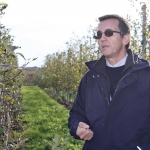
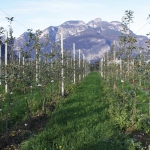
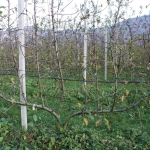
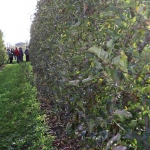
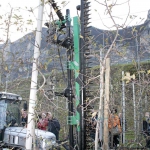





Leave A Comment